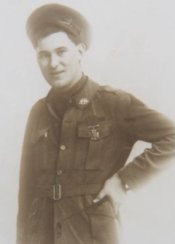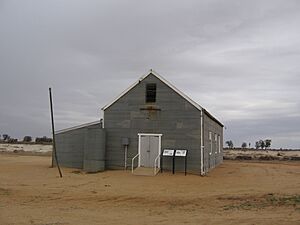Gunbar, New South Wales facts for kids
Quick facts for kids GunbarNew South Wales |
|
|---|---|

Presbyterian church
|
|
| Population | 97 (2006 census) |
| Postcode(s) | 2711 |
| Elevation | 95 m (312 ft) |
| Location | |
| LGA(s) | Carrathool Shire |
| County | Nicholson |
| State electorate(s) | Murray |
Gunbar is a small place in the Riverina area of south-western New South Wales, Australia. You can find it on a big bend of the Mid-Western Highway, between the towns of Goolgowi and Hay. It's part of the Carrathool Shire local government area. In 2006, only 97 people lived in Gunbar.
Long ago, Gunbar was a busy village. It was a central spot for the big farms and smaller landholders who moved into the area from the 1870s. Today, the Gunbar community is made up of people who live and work on the surrounding farms. The old Presbyterian church still stands on a hill, looking over where the village used to be. The only other main building left is the Community Hall, made of corrugated iron. You can still see old peppercorn trees, which are clues that a village once stood there. The Gunbar cemetery is about a mile away, near where the government had planned a new town.
Contents
History of Gunbar
Gunbar Station: A Big Farm's Story
The land that became 'Gunbar' station was first settled by Europeans in the late 1830s and early 1840s. This was when settlers were moving along the Lachlan River. By the 1870s, 'Gunbar' and nearby farms were owned by a group of partners. The name 'Gunbar' is believed to be an Aboriginal word meaning 'no meat'.
In 1881, the Armstrong brothers bought the lease for 'Gunbar' for a lot of money. John Armstrong managed the huge farm. In 1888, 'Gunbar' station was still very large, covering about 280,000 acres (1,133 square kilometers). This was even after some land had been taken by smaller settlers. After John Armstrong passed away in 1899, his son William managed the station until it was sold in 1918.
Gunbar Village: A Hub of Activity
William Spry and his brother George were successful transporters in the Hay area in the 1860s. Around 1870, William Spry built a simple hotel at the future site of Gunbar village. This spot was popular with transporters who often camped there. By 1871, Spry had applied for a license for his hotel, the Gunbar Hotel. His wife, Florence, ran the hotel while William continued his work with bullock teams. The first hotel burned down, but William rebuilt it.
A Post Office opened in Gunbar on July 1, 1879, with James McPherson as the postmaster. (It closed 100 years later in 1979). By the early 1880s, Gunbar village had the Gunbar Hotel, a blacksmith's shop, a wheelwright's shop, a Chinese market garden, and a place where mail coaches changed horses. Mail and passenger coaches, part of the famous Cobb & Co. network, traveled through Gunbar. Church services also began to be held in the hotel's dining room from 1881.
In 1883, a public school opened in Gunbar with 19 students. A large general store was also set up in Gunbar in 1884. This store sold many different goods and became a place for local dances and social events. The Post Office was moved to this store in 1899. Sadly, in May 1903, the store, including the Post Office, was destroyed by fire. After this, the owner and his family moved away.
A Slow Decline for Gunbar
The terrible Federation Drought, which lasted from the late 1890s to 1903, caused Gunbar village to shrink. Many people left the area. The drought made the land a dry, dusty desert, and many families struggled to survive. Because of this, many residents moved to nearby towns like Hillston, Hay, and Griffith in the early 1900s.
In January 1922, a very strong windstorm, like a small cyclone, hit Gunbar. It caused a lot of damage. The Public Hall was blown over and broken, and the hotel's roof was ripped off. Trees were blown down, and sheds were damaged. A new hall was built by October 1922. The Gunbar Hotel, a long-standing landmark, was destroyed by fire in December 1926. Even with these changes, the original village site continued to be a gathering place for people in the area.
The Pioneer Memorial Church
From 1881 to 1884, church services were held in the Gunbar Hotel. In July 1884, a church was built in the new, surveyed village area (north of the original settlement). This church was moved in 1914 to a higher spot near the old Gunbar village and reopened there.
In 1922, the strong windstorm that damaged the village hall also hurt the church. It was badly damaged, and even after temporary repairs, it was clear a lot of work was needed. In 1933, the local community decided to build a new church to celebrate 50 years since the first one opened. They wanted it to be a special memorial to the early settlers, who had worked together to build a church for everyone.
The new Pioneer Memorial Church opened in July 1934. It was built in the Gothic style, using "cement bricks" to keep out white ants. It also has four special windows dedicated to the memory of Gunbar's pioneers. The church was built without any debt, costing about £1,120.
'Black Stump': A Mysterious Name
The Gunbar cemetery is where Mrs. Barbara Blain is buried. Her accidental death in March 1886 might be why we have the Australian saying ‘black stump’. This phrase means a very remote place, like "beyond the black stump" or "this side of the black stump."
Barbara Blain's husband, James, was a carrier, transporting goods with horse or bullock teams. On March 10, 1886, James and Barbara Blain were camping with other carriers on 'Gunbar' station. James and the other men left to load posts, while Barbara started preparing dinner. When the men returned, they found Mrs. Blain had been badly burned, likely after her dress caught fire from the campfire. She was buried in Gunbar cemetery on March 13.
At an investigation into her death, James Blain reportedly said that when he found his wife, she "looked like a black stump." A watering hole near where this sad event happened, between Gunbar and Merriwagga, became known as Black Stump Tank.
William Jackson, VC: A War Hero
William Jackson was an Australian soldier who received the Victoria Cross (VC). The Victoria Cross is the highest award for bravery in the British and Commonwealth armed forces. He is the youngest Australian ever to receive this award.
William Jackson grew up in the Gunbar area. His father worked on "Gunbar" station. William and his brothers and sisters went to Gunbar School. Later, William worked on farms in the district.
On February 15, 1915, William Jackson joined the Australian Imperial Forces as one of the first volunteers from Gunbar. He even made himself sound a year older, with his father's permission, so he could join. William Jackson was given the Victoria Cross in 1916 for his amazing courage. He rescued his friends while under heavy enemy fire near Armentières in France during World War I.




